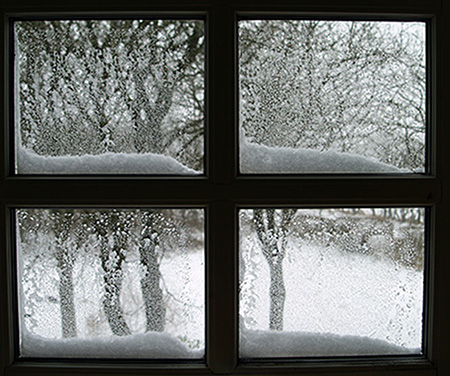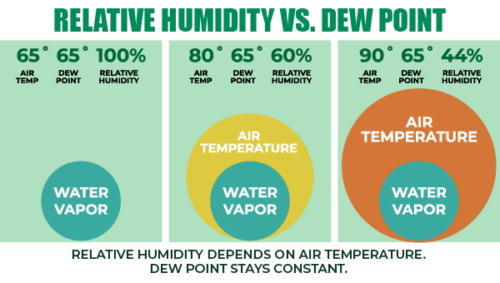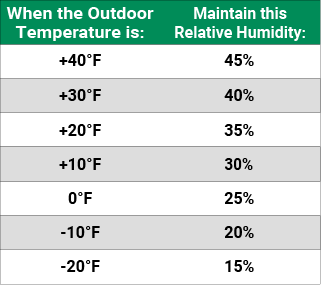
December 2023
By: Josh Walejewski
Read Time: 3 Minutes
Why does condensation form on windows during the winter months?
Have you ever woken up on a brisk winter morning to frost-covered windows? While not every home may experience this phenomenon to the same extent, the presence of condensation and frost on windows can leave many homeowners scratching their heads.
You might be thinking. Is this normal? Should I be worried? Is there anything I should do? Why is this happening? To understand this, let’s first explore the interplay between air temperature and dew point.
Dew point
While the dew point is a measure of the amount of water vapor in the air, it’s best to think of dew point as the temperature at which condensation occurs. When the air cools down to the dew point temperature, it reaches its maximum capacity to hold water vapor. If it cools further beyond that point, the excess moisture in the air turns into droplets or condensation on surfaces.

Air temperature
Temperature directly influences the air’s ability to hold moisture. Cooler air can hold less moisture than warm air. This is what weathermen are referring to when they talk about relative humidity (RH). RH tells us the amount of water vapor currently in the air versus the amount of water vapor that can be present in the air at a given temperature.
In essence, the relationship between these factors is crucial. When air temperature drops below the dew point, it can no longer hold all the moisture it did at a higher temperature. Therefore, leading to the formation of condensation or frost on surfaces like windows.
Excessive window condensation and frost can lead to problems
Mold and mildew growth:
Accumulated moisture on windows creates an ideal environment for mold and mildew growth. Breathing in mold and mildew spores poses health risks, especially for those with allergies or respiratory issues.
Damage to windows and walls
Continuous exposure to moisture from condensation and frost can cause wooden window frames and sills to deteriorate, warp, or rot over time. This can compromise the structural integrity of the window and even the surrounding exterior wall.
Several factors contribute to window condensation and frost:
Insulation
Newly constructed homes are often insulated well and sealed tightly. While this is great for energy efficiency, it can also trap too much moisture indoors. If proper ventilation isn’t maintained, the chances of condensation and frost on windows increase during winter.
Old windows or poor-quality windows
Older or cheaper windows, especially those with single-pane glass, may not offer adequate insulation. They can become colder quickly, promoting condensation and frost formation when in contact with warmer indoor air.
Warning: Presence of Carbon Monoxide
Unusual or sudden window condensation, especially when accompanied by other signs such as stuffy indoor air and persistent condensation on walls/windows could indicate the presence of CO (carbon monoxide) in your home. Other symptoms of CO include experiencing headaches, shortness of breath, and fatigue.
It’s essential to promptly check that your CO detectors are in working order and whether your gas-combusting appliance’s venting systems are functioning correctly. Regular maintenance of gas-combusting appliances such as heating equipment and water heaters helps ensure your equipment is operating safely. If you suspect any issues, seek professional assistance immediately to address potential safety concerns.
Extreme cold
Extreme temperature disparities between indoor and outdoor environments can exacerbate frost formation on windows. When the difference between indoor and outdoor temperatures is so extreme, there may be little you can do to completely prevent frosty windows. However, in less extreme situations, there are a few things that can help.
Tips to prevent window condensation and frost:
Uncover windows during freezing temperatures
You might think this would be counterintuitive, but leaving curtains, blinds, or drapes open on windows prone to frosting up can help. When windows are covered, it reduces airflow over the window’s surface. The trapped air will cool down below the dew point and moisture will stick to the window and freeze.
Set your furnace fan to ‘on’ or ‘circulate’
In addition to leaving your curtains open, running your furnace’s fan can help move air across the window’s surface. When air is constantly circulated across the window it may not cool down enough to reach the dew point temperature. If you have one problematic room or window, you can also leverage the room’s ceiling fan to circulate air over windows.
Reduce indoor humidity
Remember to utilize your kitchen and bathroom exhaust fans when engaging in activities that put out a lot of humidity, such as showering or boiling water. Check to see if your exhaust fans are working properly and that they are correctly sized to efficiently remove enough moisture.
Balancing optimal humidity in Wisconsin
 Managing indoor humidity levels during Wisconsin winter can be a difficult balancing act. When indoor humidity levels are too low, we experience reduced comfort. Low humidity levels can even impact our health. The ideal humidity range for our comfort and health is between 40% and 60% relative humidity.
Managing indoor humidity levels during Wisconsin winter can be a difficult balancing act. When indoor humidity levels are too low, we experience reduced comfort. Low humidity levels can even impact our health. The ideal humidity range for our comfort and health is between 40% and 60% relative humidity.
However, there will be times throughout the winter season when outdoor temperatures are so low that it may not always be feasible to stay within that optimal range without seeing some moisture or frost accumulate on windows.
If you have a way to see your indoor humidity levels, adhering to the chart can help if you are experiencing issues with condensation and frosty windows. Not every Wisconsin home experiences window moisture and frost for the same reasons. Employing these techniques can help combat condensation and frost buildup, offering a clearer view this winter.
Read more blog posts from Kettle Moraine Heating & AC.
About the Author
Josh Walejewski
Josh is a professional marketer who has worked in the HVAC industry since 2017. With a Bachelor of Applied Arts and Sciences Degree (B.A.A.S) in marketing and sustainable business management from the University of Wisconsin, he has a passion for all aspects of HVAC, business, marketing, and environmental stewardship.





